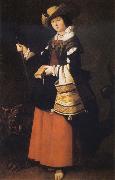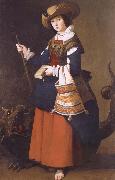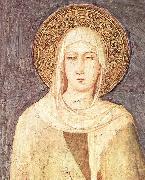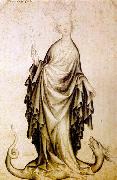Wholesale Oil Painting No Minimum |
|||||||||||
|
|
|||||||||||

|
|||||||||||
|
|
|
||||||||
ZURBARAN Francisco deSpanish Baroque Era Painter, 1598-1664 Spanish painter. He was apprenticed in 1614 to a painter in Sevilla (Seville), where he lived until 1658 when he moved to Madrid. He had a few royal commissions but remained throughout his life a provincial painter of religious pictures. His apostles, saints, and monks are painted with almost sculptural modeling, and his emphasis on the minutiae of their dress lends verisimilitude to their miracles, visions, and ecstasies. This distinctive combination of naturalism with religious sensibility conforms to the guidelines for Counter-Reformation artists outlined by the Council of Trent. He had numerous commissions from monasteries and churches throughout southern Spain, and many of his works were sent to Lima, Peru. |
||||||||
|
|
||||||||
St Margaret
St Margaret Painting ID:: 7090 |
c. 1631
Oil on canvas, 194 x 112 cm
National Gallery, London
c. 1631 Oil on canvas, 194 x 112 cm National Gallery, London |
|||||||
|
|
||||||||
Francisco de Zurbaran1598-1664 Spanish Francisco de Zurbaran Galleries Spanish baroque painter, active mainly at Llerena, Madrid, and Seville. He worked mostly for ecclesiastical patrons. His early paintings, including Crucifixion (1627; Art Inst., Chicago), St. Michael (Metropolitan Mus.), and St. Francis (City Art Museum, St. Louis), often suggest the austere simplicity of wooden sculpture. The figures, placed close to the picture surface, are strongly modeled in dramatic light against dark backgrounds, indicating the influence of Caravaggio. They were clearly painted as altarpieces or devotional objects. In the 1630s the realistic style seen in his famous Apotheosis of St. Thomas Aquinas (1631; Seville) yields to a more mystical expression in works such as the Adoration of the Shepherds (1638; Grenoble); in this decade he was influenced by Ribera figural types and rapid brushwork. While in Seville, Zurbur??n was clearly influenced by Velazquez. After c.1640 the simple power of Zurbaran work lessened as Murillo influence on his painting increased (e.g., Virgin and Child with St. John, Fine Arts Gall., San Diego, Calif.). There are works by Zurbar??n in the Hispanic Society of America, New York City; the National Gallery, Washington, D.C.; and the Philadelphia Museum of Art.. |
||||||||
|
|
||||||||
|
|
St Margaret
St Margaret Painting ID:: 33632 |
mk86
c.1630-1635
Oil on canvas
192x112cm
London,National Gallery
mk86 c.1630-1635 Oil on canvas 192x112cm London,National Gallery |
||||||
|
|
||||||||
Francisco de Zurbaran1598-1664 Spanish Francisco de Zurbaran Galleries Spanish baroque painter, active mainly at Llerena, Madrid, and Seville. He worked mostly for ecclesiastical patrons. His early paintings, including Crucifixion (1627; Art Inst., Chicago), St. Michael (Metropolitan Mus.), and St. Francis (City Art Museum, St. Louis), often suggest the austere simplicity of wooden sculpture. The figures, placed close to the picture surface, are strongly modeled in dramatic light against dark backgrounds, indicating the influence of Caravaggio. They were clearly painted as altarpieces or devotional objects. In the 1630s the realistic style seen in his famous Apotheosis of St. Thomas Aquinas (1631; Seville) yields to a more mystical expression in works such as the Adoration of the Shepherds (1638; Grenoble); in this decade he was influenced by Ribera figural types and rapid brushwork. While in Seville, Zurbur??n was clearly influenced by Velazquez. After c.1640 the simple power of Zurbaran work lessened as Murillo influence on his painting increased (e.g., Virgin and Child with St. John, Fine Arts Gall., San Diego, Calif.). There are works by Zurbar??n in the Hispanic Society of America, New York City; the National Gallery, Washington, D.C.; and the Philadelphia Museum of Art.. |
||||||||
|
|
||||||||
|
|
St Margaret
St Margaret Painting ID:: 55770 |
mk244
Oil on canvas
192x112cm
London
mk244 Oil on canvas 192x112cm London |
||||||
|
|
||||||||
Simone Martini1283-1344 Italian Simone Martini Locations He was a major figure in the development of early Italian painting and greatly influenced the development of the International Gothic style. It is thought that Martini was a pupil of Duccio di Buoninsegna, the leading Sienese painter of his time. His brother-in-law was the artist Lippo Memmi. Very little documentation survives regarding Simone's life, and many attributions are debated by art historians. Simone Martini died while in the service of the Papal court at Avignon in 1344. Simone was doubtlessly apprenticed from an early age, as would have been the normal practice. Among his first documented works is the Maest?? of 1315 in the Palazzo Pubblico in Siena. A copy of the work, executed shortly thereafter by Lippo Memmi in San Gimignano, testifies to the enduring influence Simone's prototypes would have on other artists throughout the fourteenth century. Perpetuating the Sienese tradition, Simone's style contrasted with the sobriety and monumentality of Florentine art, and is noted for its soft, stylized, decorative features, sinuosity of line, and unsurpassed courtly elegance. Simone's art owes much to French manuscript illumination and ivory carving: examples of such art were brought to Siena in the fourteenth century by means of the Via Francigena, a main pilgrimage and trade route from Northern Europe to Rome. Simone's major works include the Maest?? (1315) in the Palazzo Pubblico in Siena, St Louis of Toulouse Crowning the King at the Museo di Capodimonte in Naples (1317), the S. Caterina Polyptych in Pisa (1319) and the Annunciation and two Saints at the Uffizi in Florence (1333), as well as frescoes in the Chapel of St. Martin in the lower church of the Basilica of San Francesco d'Assisi. Francis Petrarch became friend with Simone while in Avignon, and two of his sonnets make reference to a portrait of Laura de Noves he supposedly painted for the poet. |
||||||||
|
|
||||||||
|
|
St Margaret
St Margaret Painting ID:: 64642 |
1318 Fresco, 67 x 55 cm (size of detail) Lower Church, San Francesco, Assisi According to the legend St Margaret was thrown into prison because she rejected Olybrius, the Roman governor. In the prison she was attacked by the Devil and, while at prayer, swallowed by a dragon. Since she was carrying a small crucifix she was able to cut a hole in the monsters belly and escaped. Her attributes are the cross and the dragon. Artist:SIMONE MARTINI Title: St Margaret (detail), 1301-1350, Italian , painting , religious 1318 Fresco, 67 x 55 cm (size of detail) Lower Church, San Francesco, Assisi According to the legend St Margaret was thrown into prison because she rejected Olybrius, the Roman governor. In the prison she was attacked by the Devil and, while at prayer, swallowed by a dragon. Since she was carrying a small crucifix she was able to cut a hole in the monsters belly and escaped. Her attributes are the cross and the dragon. Artist:SIMONE MARTINI Title: St Margaret (detail), 1301-1350, Italian , painting , religious |
||||||
|
|
||||||||
|
|
||||||||
|
|
St Margaret
St Margaret Painting ID:: 65252 |
1400 Brush, Chinese ink, red chalk, 21.4 X 14 cm Museum of Fine Arts, Budapest This lovely sheet is one of the drawings made about 1400, which are on the borderline of drawing as an autonomous genre. It may have been the preparatory sketch for a picture or a sculpture, or its subsequent copy; or else it may have served for a model drawing. Up to now no direct connection with existing works of art has been established. The drawing produced by the brush in greyish-black Chinese ink and coloured by red chalk is so delicate and exquisite, asserting three-dimensional values and effects of light with such a number of nuances, that for us it represents self contained artistic values of a very high level indeed. The main reason why it is so difficult to fix the place where the work was created is that it represents in a very highly developed form and exceptional quality the style of the time about 1400, an art interwoven from several European trends. It was originally considered to have been the work of a Cologne master, then an Austrian one, while Oettinger, due to the relationship between the drawing and the P?hl Altarpiece, had in mind a master of the Augsburg region, but working under the effect of Bohemian art. Czech scholars revealed some connections, both of form and of shape, with the so-called "beautiful Madonnas" and a group of paintings produced under their influence. Indeed, the equilibrium of the figure brought about by movements of opposite directions, and, above all by the dense and deep folds of the wide garment which completely conceals the body, draperies that fall downwards on either side like a cascade, the edges showing rhythmically undulating lines, as well as the three-dimensional modelling of the soft, heavy folds are reminiscent of the Beautiful Madonna of Krumlov and the sculptures and paintings inspired by it. The composition of the drawing is carefully poised. The dragon at the saint's feet provides a pedestal broad enough for the slender figure in her ample garments. The mass of the dragon's head is counterbalanced by the sling made by the end of its tail, whereas the line of the saint's body leaning towards the right is counterpoised by an imaginary diagonal line drawn from the dragon's head to the cross. The abundant drapery falling onto the right hip is a characteristic example of how in the International Gothic style draperies achieved the status of elements from which a picture can be constructed, motifs that have an independent life of their own. Artist: UNKNOWN MASTER, Bohemian , St Margaret , 1351-1400 , Bohemian , graphics , religious 1400 Brush, Chinese ink, red chalk, 21.4 X 14 cm Museum of Fine Arts, Budapest This lovely sheet is one of the drawings made about 1400, which are on the borderline of drawing as an autonomous genre. It may have been the preparatory sketch for a picture or a sculpture, or its subsequent copy; or else it may have served for a model drawing. Up to now no direct connection with existing works of art has been established. The drawing produced by the brush in greyish-black Chinese ink and coloured by red chalk is so delicate and exquisite, asserting three-dimensional values and effects of light with such a number of nuances, that for us it represents self contained artistic values of a very high level indeed. The main reason why it is so difficult to fix the place where the work was created is that it represents in a very highly developed form and exceptional quality the style of the time about 1400, an art interwoven from several European trends. It was originally considered to have been the work of a Cologne master, then an Austrian one, while Oettinger, due to the relationship between the drawing and the P?hl Altarpiece, had in mind a master of the Augsburg region, but working under the effect of Bohemian art. Czech scholars revealed some connections, both of form and of shape, with the so-called "beautiful Madonnas" and a group of paintings produced under their influence. Indeed, the equilibrium of the figure brought about by movements of opposite directions, and, above all by the dense and deep folds of the wide garment which completely conceals the body, draperies that fall downwards on either side like a cascade, the edges showing rhythmically undulating lines, as well as the three-dimensional modelling of the soft, heavy folds are reminiscent of the Beautiful Madonna of Krumlov and the sculptures and paintings inspired by it. The composition of the drawing is carefully poised. The dragon at the saint's feet provides a pedestal broad enough for the slender figure in her ample garments. The mass of the dragon's head is counterbalanced by the sling made by the end of its tail, whereas the line of the saint's body leaning towards the right is counterpoised by an imaginary diagonal line drawn from the dragon's head to the cross. The abundant drapery falling onto the right hip is a characteristic example of how in the International Gothic style draperies achieved the status of elements from which a picture can be constructed, motifs that have an independent life of their own. Artist: UNKNOWN MASTER, Bohemian , St Margaret , 1351-1400 , Bohemian , graphics , religious |
||||||
|
|
||||||||
|
unknow artist St Margaret 1400 Brush, Chinese ink, red chalk, 21.4 X 14 cm Museum of Fine Arts, Budapest This lovely sheet is one of the drawings made about 1400, which are on the borderline of drawing as an autonomous genre. It may have been the preparatory sketch for a picture or a sculpture, or its subsequent copy; or else it may have served for a model drawing. Up to now no direct connection with existing works of art has been established. The drawing produced by the brush in greyish-black Chinese ink and coloured by red chalk is so delicate and exquisite, asserting three-dimensional values and effects of light with such a number of nuances, that for us it represents self contained artistic values of a very high level indeed. The main reason why it is so difficult to fix the place where the work was created is that it represents in a very highly developed form and exceptional quality the style of the time about 1400, an art interwoven from several European trends. It was originally considered to have been the work of a Cologne master, then an Austrian one, while Oettinger, due to the relationship between the drawing and the P?hl Altarpiece, had in mind a master of the Augsburg region, but working under the effect of Bohemian art. Czech scholars revealed some connections, both of form and of shape, with the so-called "beautiful Madonnas" and a group of paintings produced under their influence. Indeed, the equilibrium of the figure brought about by movements of opposite directions, and, above all by the dense and deep folds of the wide garment which completely conceals the body, draperies that fall downwards on either side like a cascade, the edges showing rhythmically undulating lines, as well as the three-dimensional modelling of the soft, heavy folds are reminiscent of the Beautiful Madonna of Krumlov and the sculptures and paintings inspired by it. The composition of the drawing is carefully poised. The dragon at the saint's feet provides a pedestal broad enough for the slender figure in her ample garments. The mass of the dragon's head is counterbalanced by the sling made by the end of its tail, whereas the line of the saint's body leaning towards the right is counterpoised by an imaginary diagonal line drawn from the dragon's head to the cross. The abundant drapery falling onto the right hip is a characteristic example of how in the International Gothic style draperies achieved the status of elements from which a picture can be constructed, motifs that have an independent life of their own. Artist: UNKNOWN MASTER, Bohemian , St Margaret , 1351-1400 , Bohemian , graphics , religious |
||||||||
|
|
||||||||
|
Prev Next
|
||||||||
|
|
||||||||
|
Related Paintings to unknow artist :. |
||||||||
|
|
||||||||
|
CONTACT US |





